EAST HAM, E 6.
| Ham or Hamme was mentioned in Saxon times, when in 958 King Edgar granted lands covering most of the present Newham to an East Anglian called Ealdorman Athelstan. The word Ham is connected with the modern English word home and was used in many place names like Dagenham or Rainham. After the Norman conquest the two manors (East and West) were given to two Normans called Ranulph Peverel and Robert Gernon. Part was also owned by the Abbey of St Peters (later known as Westminster Abbey). |
PUT MOUSE OVER  TO READ NAME ~ CLICK FOR PHOTO & EXPLANATION.
TO READ NAME ~ CLICK FOR PHOTO & EXPLANATION.
CONTENTS | ||
| 1. ANNE BOLEYN. | 2. CO-OPERATIVE URNS. | 3. EAST HAM COAT OF ARMS. |
| 4. EAST HAM HALL. | 5. THE ECLIPSE PANELS. | 6. FLORAL WALL. |
| 7. ELIZABETH FRY. | 8. GREEN STREET PAVEMENT. | 9. HOLLY. |
| 10. NEWHAM ACCADEMY OF MUSIC. | 11. NEWHAM COLLEGE MURAL. | 12. NEWHAM TOWN HALL. |
| 13. MADONNA AND CHILD. | 14. ST. BARTHOLEMEWS. | 15. SCHOOL MURAL. |
| 16. STATION PARADE. | 17. TREE HOUSE. | 18. WAR MEMORIAL. |
| 19. "WE ARE THE CHAMPIONS.". | 20. WEST HAM UNITED. | 21. WHITE HORSE 1. |
| 22. WHITE HORSE 2. | 23. WORSHIPPERS. | |
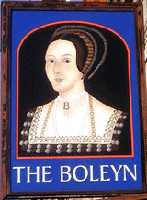 |
Anne Boleyn. |
|
Sign of the Boleyn pub on the corner of Barking Road and Green Street. The name is derived from a local legend that Anne Boleyn was associated with the area. It is known that when in 1546, Richard Breame (servant of Henry VIII) died, his will mentioned his house and grounds at this end of Green Street, which he had bought from the King. The house eventually became known as Boleyn Castle. The legend states that Henry courted Anne Boleyn here, but there is no evidence to support this. Castle Street and Tudor Road which are off Green Street are much later names. There are also modern roads named Boleyn, Seymour, Cleeves, Parr and Arragon near by, while Howard Road is to the east of Central Park. So, all of Henry's wives are remembered in East Ham. (See No. 1. on the MAP ) |
||
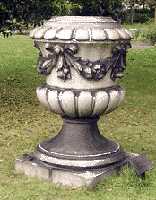 |
Co-operative Urns. |
|
Central Park, East Ham. One of four urns now set up in the northern part of the park. These came from the roof of the East Ham Co-operative building, when it was demolished in 1989. They date from 1929. For the history of Central Park see East Ham Hall. (See No. 2. on the MAP ) |
||
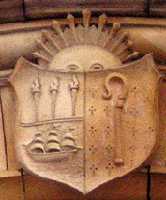 |
East Ham Coat of Arms. |
|
The Town Hall building, entrance from Barking Road. There are two versions of these arms on the town hall buildings, which differ slightly. The other has flowery additions to it. These arms can now only be seen on old buildings because since 1965, when East Ham and West Ham became reunited into Newham, this crest ceased to be used. (See No. 3. on the MAP ) |
||
 |
East Ham Hall. |
|
Central Park at the corner of one of the rose beds in the rose garden. East Ham Hall was the manor house which stood near the parish church; but whose manor stretched to this area. In 1369 Walter Hewet, then the current owner, was given permission to crenellate the hall. Later it appears to have been called Rancliffe House. In 1898 the owner, Col. Burges, donated a portion of his land to be turned into the present Central Park. This border stone of the manor is inscribed on one face with the words: MANOR of EAST HAM HALL. There was another inscription on another face of the stone which is now illegible. (See No. 4. on the MAP ) |
||
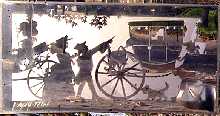 |
The Eclipse Panels. |
|
Near the eastern end of Barking Road, at the entrances to a housing complex named Dukes Court. The photo shows one of eight designs in silhouette depicting different periods in history and modes of transport. On each of the dates chosen for illustration there was a total eclipse of the sun. This accounts for the fact in most of the panels, at least one figure is either pointing to or looking up at the sky. The panels have been executed in a silvery metallic material which is highly reflective. (See No. 5. on the MAP ) |
||
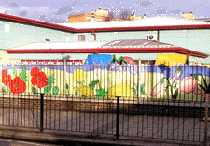 |
Floral Wall. |
|
Green Street, tight next to West Ham football ground. This series of floral paintings forms a screen to provide some privacy to the children in the nursery school. (See No. 6. on the MAP ) |
||
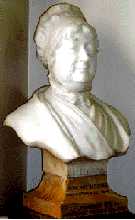 |
Elizabeth Fry. |
|
Bust in the Reference Library on the first floor of the Library in High Street South, East Ham. Elizabeth Fry (1780 – 1845) lived for 20 years in Plashet House, West Ham. A member of a Quaker family was so shocked at the conditions she found when visiting a prisoner that she devoted her whole life working for an improvement. (See No. 7. on the MAP ) N. A. Pegram. Date: 1903. |
||
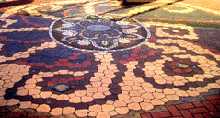 |
Green Street Pavement. |
|
Green Street, Upton Park, E6. Decorative pavement in the Eastern style covering quite a wide area, with several benches similarly designed. The themes of the designs are "Our bodies, ourselves and global links." Designs for the pavement were made by the pupils of St Angela's Ursuline Convent School, St Bonaventure's Secondary School, Sandringham Primary School, Selwyn Primary School and St Edward's Primary School. Adults taking part came from Asian Elders at Subco, Newham Asian Women's Project and Domincan UK Association. Peter Dunn was the lead artist and coordinator of the project. (See No. 8. on the MAP. For other works of Peter Dunn see "Dragon's Gate" and "Awakening"). Date: 2000. |
||
 |
"Holly." |
|
Stondon Walk, Barking Road, near to junction with St. Bernard's Road. One of seven on the theme of nature accompanied by the words of a poem on the same theme by Kathleen Raine (born 1903.) The panels are in order the seasons, starting with spring daffodils on the left ending with this one of Holly on the right. (See No. 9. on the MAP ) Artist: Stephen John Peart. Date: c. 2000. |
||
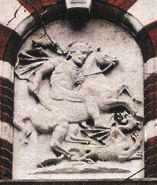 |
Newham Academy of Music. |
|
Wakefield Street, E6. St. George and the dragon. On the front of the building, but shrouded by trees in summer. The building was previously occupied by the East Ham Education Offices and was also known as the School Board Office. (See No. 10. on the MAP ) Date: 1899. |
||
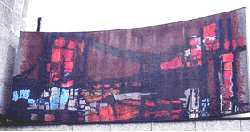 |
Newham College Mural. |
|
Large abstract mosaic mural over the front entrance of the Newham College of Art, easily seen from East Ham High Street South, E6. (See No. 11. on the MAP ) |
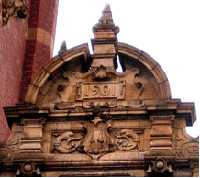 |
Newham Town Hall. |
Formerly East Ham Town Hall. The decoration includes the scales of justice, which the council aimed to deliver. (See No. 12. on the MAP ) Date: 1901. |
||
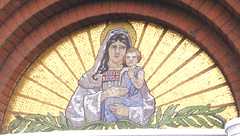 |
Madonna and Child. | |
Green Street, over the main door of the Roman Catholic Church of Our Lady of Compassion. This mosaic shows Mary with the infant Jesus. (See No. 13. on the MAP ) |
 |
St Bartholemews. |
Barking Road, by the corner with Navarre Road. Statue of a family group of mother, father and child. (See No. 14. on the MAP ) Sculptor: John Bridgeman. Date: 1983. |
||
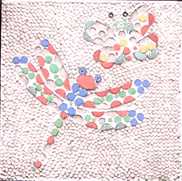 |
School Mural. |
|
The Napier Junior School lies between Napier Road and Ranelagh Road. This is one of a series of textured surface murals which surrounds the play area which can be seen from Ranelagh Road. (See No. 15. on the MAP ) |
||
 |
Station Parade. |
|
Above the shops in High Street North facing the entrance to East Ham Underground Station. The pair of wings has at the centre the staff of Mercury, the messenger of the gods. This is not only the sign of medicine but also the sign of commerce. Some of the travellers coming out of the station might look up and wonder just how much faster their journey might have been if they too had winged sandals. (See No. 16. on the MAP ) Date: 1931. |
||
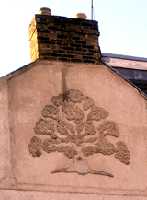 |
Tree House. |
|
On 213 Burges Road at the junction with Leigh Road. This end of terrace house has a tree sculpture on it's side wall. Fashioned in relief it stands out from the wall. So that rather than being a house in a tree, this is a tree on a house. (See No. 17. on the MAP ) |
||
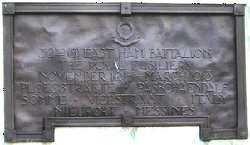 |
War Memorial. |
|
Central Park off High Street South. This 1st World War memorial has had to inscribe the names in very small writing as so many men were killed. There must be over two thousand names of men recorded here who all came from East Ham. This is one of four inscriptions and states: The Royal Fusiliers November 1915 – March 1918 Ploegstraete – Paschaendale Somme – Vierstraat – Italy Nieuport – Messines (See No. 18. on the MAP ) |
||
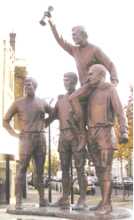 |
"We Are The Champions." |
|
At the junction of Barking Road and Central Park Road. Showing Bobby Moore, holding the Cup, with Geoff Hurst, Martin Peters and Ray Wilson. This shows the four celebrating after England won the World Cup in 1966. The artist has depicted these soccer heroes as being larger than life. (See No. 19. on the MAP ) Sculptor: Philip Jackson. Date: 2003. |
||
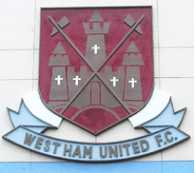 |
West Ham United. |
|
Priory Road over the gate to the Bobby Moore Stand of Upton Park football ground. The crossed hammers came from The Thames Ironworks (shipbuilders) whose football club was one of three work teams that joined together in 1900 to form the West Ham United FC. The castle came from the Old Castle Swifts, the club of the Union Castle Steamship Line. The third club was St Luke's FC which gave rise to the white crosses. These three clubs were from West Ham, while the stadium is in East Ham. Football was played the area for at least 300 years before the foundation of the club and violence on the pitch has decreased. For in 1582 a man was murdered during a game in West Ham. Bobby Moore (1941–1993) captained both West Ham and England and is featured in the previous item. (See No. 20. on the MAP ) |
||
 |
White Horse 1. |
|
On the roof of 441 - 445 Barking Road there is a life-size statue of a horse. This predates the Chinese restaurant which now occupies the site and has absolutely nothing to do with the food served here. Another occupant of the block says that about 1900, the building was occupied by a vet, and that this probably accounts for the presence of the horse. It was a common practice for a vet to advertise his practice with a horse, just as a barber had a pole and pawnbroker had three balls. (See No. 21. on the MAP ) |
||
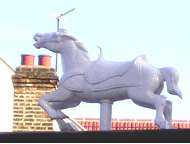 |
White Horse 2. |
|
High Street South where it meets White Horse Road. This horse looks like it came from a fairground roundabout and was then painted white. There has been a white horse pub on this street from at least the 16th century, but the old building was on the other side of the road. The road, itself, was formerly called East Ham Manor Road. (See No. 22. on the MAP ) |
||
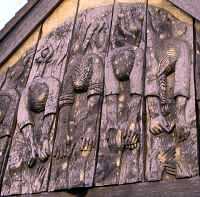 |
Worshippers |
|
St Pauls Church, Burges Road at the junction with Watson Avenue. This photo shows part of a wood carving over the porch, showing worshippers with bowed heads. (See No. 23. on the MAP ) Sculptress: Jane Quail. |
||
OTHER AREAS COVERED:-
|| Beckton || Bethnal Green || Blackwall || Bow || Bromley-by-Bow || Canary Wharf || Canning Town || Chingford || Cubit Town || Custom House || East India Dock || Forest Gate || Higham's Park || Leyton || Leytonstone || Limehouse || Little Ilford || Manor Park || Mile End || Millwall || North Woolwich || Plaistow || Plashet || Poplar || St George's || St Katharine Dock || Shadwell || Shoreditch || Silvertown || Snaresbrook || Spitalfields || Stepney || Stratford || Upton || Walthamstow East || Walthamstow Village || Walthamstow West || Wanstead || Wapping || West India Dock || Whitechapel || Woodford || |